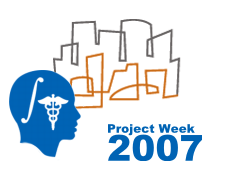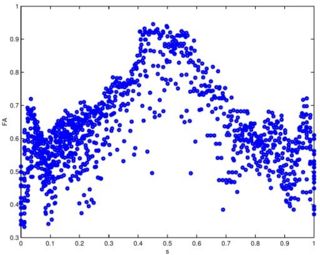Difference between revisions of "Projects/Structural/2007 Project Week EMSegmentation Validation"
| Line 21: | Line 21: | ||
<div style="width: 27%; float: left; padding-right: 3%;"> | <div style="width: 27%; float: left; padding-right: 3%;"> | ||
| − | <h1> | + | <h1>Approach, Plan</h1> |
| + | |||
| + | Our approach for analyzing diffusion tensors is summarized in the IPMI 2007 reference below. The main challenge to this approach is <foo>. Our plan for the week is <bar>. | ||
| − | |||
</div> | </div> | ||
| Line 30: | Line 31: | ||
<h1>Progress</h1> | <h1>Progress</h1> | ||
| − | |||
| − | |||
| − | |||
| − | |||
| − | |||
Software for the fiber tracking and statistical analysis along the tracts has been implemented. The statistical methods for diffusion tensors are implemented as ITK code as part of the [[NA-MIC/Projects/Diffusion_Image_Analysis/DTI_Software_and_Algorithm_Infrastructure|DTI Software Infrastructure]] project. The methods have been validated on a repeated scan of a healthy individual. This work has been published as a conference paper (MICCAI 2005) and a journal version (MEDIA 2006). Our recent IPMI 2007 paper includes a nonparametric regression method for analyzing data along a fiber tract. | Software for the fiber tracking and statistical analysis along the tracts has been implemented. The statistical methods for diffusion tensors are implemented as ITK code as part of the [[NA-MIC/Projects/Diffusion_Image_Analysis/DTI_Software_and_Algorithm_Infrastructure|DTI Software Infrastructure]] project. The methods have been validated on a repeated scan of a healthy individual. This work has been published as a conference paper (MICCAI 2005) and a journal version (MEDIA 2006). Our recent IPMI 2007 paper includes a nonparametric regression method for analyzing data along a fiber tract. | ||
Revision as of 02:20, 26 May 2007
Home < Projects < Structural < 2007 Project Week EMSegmentation Validation Return to Project Week Main Page |
Key Investigators
- Kitware: Brad Davis
- BWH: Sylvain Bouix
Objective
We are developing methods for analyzing diffusion tensor data along fiber tracts. The goal is to be able to make statistical group comparisons with fiber tracts as a common reference frame for comparison.
Approach, Plan
Our approach for analyzing diffusion tensors is summarized in the IPMI 2007 reference below. The main challenge to this approach is <foo>. Our plan for the week is <bar>.
Progress
Software for the fiber tracking and statistical analysis along the tracts has been implemented. The statistical methods for diffusion tensors are implemented as ITK code as part of the DTI Software Infrastructure project. The methods have been validated on a repeated scan of a healthy individual. This work has been published as a conference paper (MICCAI 2005) and a journal version (MEDIA 2006). Our recent IPMI 2007 paper includes a nonparametric regression method for analyzing data along a fiber tract.
Publications
- Fletcher, P.T., Tao, R., Jeong, W.-K., Whitaker, R.T., "A Volumetric Approach to Quantifying Region-to-Region White Matter Connectivity in Diffusion Tensor MRI," to appear Information Processing in Medical Imaging (IPMI) 2007.
- Corouge, I., Fletcher, P.T., Joshi, S., Gilmore, J.H., and Gerig, G., "Fiber Tract-Oriented Statistics for Quantitative Diffusion Tensor MRI Analysis," Medical Image Analysis 10 (2006), 786--798.
- Corouge, I., Fletcher, P.T., Joshi, S., Gilmore J.H., and Gerig, G., Fiber Tract-Oriented Statistics for Quantitative Diffusion Tensor MRI Analysis, Lecture Notes in Computer Science LNCS, James S. Duncan and Guido Gerig, editors, Springer Verlag, Vol. 3749, Oct. 2005, pp. 131 -- 138
- C. Goodlett, I. Corouge, M. Jomier, and G. Gerig, A Quantitative DTI Fiber Tract Analysis Suite, The Insight Journal, vol. ISC/NAMIC/ MICCAI Workshop on Open-Source Software, 2005, Online publication: http://hdl.handle.net/1926/39 .

